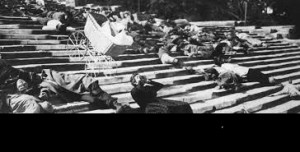 History tells us that in 1934, nine years after Battleship Potemkin was filmed, Joseph Goebbels met with film directors of his country and urged them to produce “a Nazi Potemkin.”
History tells us that in 1934, nine years after Battleship Potemkin was filmed, Joseph Goebbels met with film directors of his country and urged them to produce “a Nazi Potemkin.”
Had Hitler seen the movie?
It’s a possibility, if you consider that, in addition to being a movie lover, Battleship Potemkin (1925) had been premiered in Berlin before the Führer and his coterie took power and condemned it to the bonfire.
What is certain is that the Nazis were so impressed by the film directed by Sergei Eisenstein that they wanted an equivalent for their cause, without considering the insurmountable difficulty that such a venture entailed: Potemkin was not only the reflection of a new social world on the rise against oppression, but also an artistic-cinematographic revolution which critics and specialists – almost a century after the film was made – are still taking their hats off to today, considered among the all-time best.
Eisenstein would recognize that without the Bolshevik Revolution, he would not have been a filmmaker. He created a monumental triptych that continues to be an essential area of study in any film school: Strike (1924), Potemkin, a year later, and October, which premiered in 1928.
Following the triumph of the Great October Socialist Revolution, with mass illiteracy of around 80% of the population, the social impact of film did not escape Lenin: “The cinema is for us the most important of all the arts.” A school was created following the principles of “a revolutionary cinema for the revolution,” with “experimentation as a system,” which would soon place Soviet cinema in the international artistic vanguard, once the obstacle of the civil war, which extended to 1921, was overcome. The war in turn served to sharpen the aesthetic vision of filmmakers who would make history, as was the case of Eisenstein, himself a member of the Red Army.
The concept that a new socialist state would need an artistic vision largely marked by experimentation was fundamental for what was to come in terms of innovative ideas and film theory that, among other contributions, incorporated the choral drama of the masses.
No other cinematographic work has caused as many political, social, and aesthetic controversies as Potemkin, described for years on many screens of the world as representing true red terror, and, therefore, unworthy of being appreciated.
Bad weather in Leningrad led to Potemkin being made, rather than the film that Eisenstein had initially proposed to commemorate the 20th anniversary of the revolutionary uprising of 1905. Having traveled to Odessa with the aim of filming some short scenes for what would be the first project, he fell in love with the story of the mutiny that took place on the battleship Potemkin and decided to rewrite the script. The result was three months of filming, using non-professional actors and a dialectical discourse that with a renewed use of close-ups and montage saw cinematographic art soar to its highest peak.
It is difficult to forget the dynamic articulation of marble lions in the midst of the struggle, or the Odessa Steps sequence (lasting six minutes, with 160 separate shots), the film synthesis par excellence of a diverse range of drama, later repeatedly revered by modern cinema, especially the famous scene with the baby’s pram rolling down the stairs.
The seismic force that Eisenstein and his theory of montage of attractions would establish even reached the fields of the novel, poetry, and theater.
Then came October, the highest expression of the Revolution of 1917, with memorable scenes, including that of Lenin proclaiming victory and the storming of the Winter Palace, one of the most reproduced images in film history.
When commenting on October in a Mexican publication, Julio Antonio Mella wrote:“The public, accustomed to the bourgeois style of the Yankee film, will not be fully able to appreciate this effort from Sovkino. It does not matter. It would be asking as much of them to comprehend the proletarian revolution after hearing about it through the cables of United Press, or the revolutionary movement of our country and our national characteristics, by means of the interpretations given them by Hollywood. However, the ideological avant-gardes have here an opportunity to enjoy one of the most intense pleasures that the current age can offer in the field of art.”
That unique cinema born with the Bolshevik October, and revered in the artistic sphere by representatives of all ideologies, would end up being distorted to some extent by manipulations completely unrelated to revolution or to art. However, what it left to posterity is more than enough to ensure that 100 years later it has not been forgotten.
(Granma)